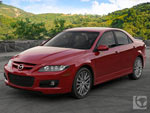 When you strike gold, dig deep and dig fast, for it won't be long before those other guys rush in and start helping themselves to your discovery. Subaru had over a year to enjoy its self-made jackpot known as the Impreza WRX, a car whose particular formula of fast, cheap, practical fun had it flying off the shelves in late 2001 like miniature American flags. Eventually, Mitsubishi stepped in with the Lancer Evolution, which quickly became the biggest success they've got going to this day.
When you strike gold, dig deep and dig fast, for it won't be long before those other guys rush in and start helping themselves to your discovery. Subaru had over a year to enjoy its self-made jackpot known as the Impreza WRX, a car whose particular formula of fast, cheap, practical fun had it flying off the shelves in late 2001 like miniature American flags. Eventually, Mitsubishi stepped in with the Lancer Evolution, which quickly became the biggest success they've got going to this day.Now Mazda wants in. Figuring three might be a crowd with those two duking it out at the rally-racer end, Mazda thought it might try frying a bigger fish: Subaru's Legacy GT. Hey, when you're Mazda, you gots to choose your battles wisely, and anyway, its 6 already has a well-earned reputation for being the raciest family transport capsule around, so why not expand on that?
So Mazda got to work, stiffening the structure and suspension (torsional rigidity's up 50%), upping the horsey herd to 274, and slamming them to the ground through the first all-wheel-drive system seen on a Mazda car since the 1991 Prot?g?. A new hood, wheels, lights, and everything else you'd expect is all there, and more critically, all Mazda. To clarify: the sexed-up 6 is virtually free of Ford pollution, with no Taurus V6 to be found and construction taking place in Hofu to prevent build quality from falling flat as a rock.
And there you have it: the next level of mid-priced mid-sized sedan performance.
Road Test

Is it the next level, though? Five years ago, the very mention of 274 horsepower would have made the common family man choke on his chalupa, but in modern times that's just 6 more than garden-variety Camrys and 6 less than the new record-holder, the Passat. Oh, but wait, the Toyota and Vee-Dub feed the power through that horse-killing machine known as an automatic transmission. As a result, both are stuck doing the 0-60 run in right around 6 seconds while Mazda's purebreds trot to the finish line in 5.4 (same as a 1990s BMW M3 or Audi S4!). So to answer the question, assuming it was about acceleration: yes, this is the next level. It's also the fastest Mazda of the moment, showing its blackened taillights to even the RX-8.
The availability of a stick (actually, it's mandatory) is just one illustration of how Mazda's path to performance is more interesting than most. Here's another: a Hitachi turbocharger shoves more than twice the pressure of the atmosphere (15.6 psi) into the engine's 2.3 little liters. And this: helping the turbo out is direct fuel injection (a hyped topic if you've been listening to Isuzu and Audi lately), a more efficient method of injecting fuel that makes heat less of an issue - pretty important on a turbo car - and allows power-boosting higher compression ratios. Put it all together and we get each liter of engine packing 119 horses, promising a power delivery with all the subtlety of getting hit by a UPS truck.
Well, it's more complicated than that, so here's how it goes down: the turbo starts spinning at 2,500 RPM, saving the big bang until 3,000 (incidentally, the point where torque climaxes) then you start blowing past clusters of cars at a time and feel unstoppable. Keep your foot on the floor, though, and the rate of acceleration (and adrenaline) seems to taper off a bit. In other words, in the MazdaSpeed 6 you get a hollow bottom end and a good top end sandwiching a furious mid-range (zoom-BOOM-zoom?) and Mazda's efforts to mellow out the transition made the boom more of a whoosh. Further dampening the sensations is the surprisingly non-descript exhaust note.
While working on the powertrain, Mazda successfully cured the clutch of its vague feel, but like the RX-8's it's still a tad tricky: it engages near the top in a sudden manner, while the slightly aggressive return spring and slightly insensitive gas pedal team up to divide and conquer your feet. Get the hang of it, though, and you're free to concentrate on rowing the shifter's six gears with the same slick precision found in a standard 6 (though it occasionally get snagged en route to 3rd). And as for the middle pedal, it feels as excellent as its scant 113-foot stopping distance implies.
The 6's suspension wasn't altered too drastically either. It now rests 4.9 inches off the ground and stands on front legs with 25% higher spring rates and a 1mm fatter stabilizer bar (24mm). Logically, the rear got stiffened further (37%) with a 2mm fatter bar (23) and reinforced crossmembers to boot. (The press materials make no mention of shocks, though Mazda's website claims 25% stiffer front shocks, hmmm.) The wheels measure 18 inches in diameter by 7 across (just like on the V6-powered 6), and no one even touched the steering rack.
Of course, the 6 had the liveliest chassis before anyone touched anything, so it's a given that the MazdaSpeed 6 would impress with its alertness, fluid feel, and sublimely sensitive steering that reliably relays subtleties of the surface that most Japanese cars would deprive you of. The MazdaSpeed mods just make the connection even more secure and body roll even less evident.
It's also nice to have good grip (0.87g), really nice to have limited-slip center and rear differentials helping to redistribute power, and just great to be able to swing out the tail (by a little if you lift the throttle in mid-bend, by a lot if you nail the brakes). Still, with the front tires always doing at least half the work (the power split only varies between 100/0 and 50/50) and pulling more than half the pounds (all 3,589 of them), they're usually the first ones to go. The all-wheel-drive greatly enhances wet-weather traction, but in a car like this that should only be half the point.
Mazda's conservatism does have its upsides. While the thicker stabilizer bars definitely amplify side-to-side head toss on more mountainous bumps, the difference on most roads isn't as pronounced, so the stiff ride remains civil. Road noise remains the greatest intrusion when the asphalt gets ugly, but with down-to-Earth tire sizes, also remains within reason. Another point in the 6's day-to-day livability is 23 MPG (even with several turbo windups and triple-digit visits) - which goes to show what six cogs and a little turbo engine can do for ya. Following that, the 6 has an asset Evo owners only see in their dreams: a cruising range in the 300s.
Unlike other cars of its ilk, the MazdaSpeed 6 was clearly aimed at those who drive on straight streets as much as curved ones - always an agreeable approach. A little too agreeable, if you ask me.
Inside and Out

If there's a majority opinion on the base Mazda 6 being the coolest-driving midsize sedan, it's borderline unanimous that it's the most sensational to look at, with a body that's got "SPEED!" written between its classy lines. Too bad there was zip-zero disagreement on the MazdaSpeed touches transforming it into a gawky dud. The dull gray 15-spoke wheels seem more fit to a Chrysler minivan (spokes are contrary to aerodynamics anyway), the stick-in-the-roof antenna adds clutter, the blackened taillights are just nasty, the bulge in the hood (needed for the top-mounted intercooler) was deemed disgusting by all, and if you look closely, what appear to be two grand exhaust pipes are no more real than Pamela Anderson's two most recognizable assets. At least the lip spoiler proves more functional than the wing-type on the standard 6.
Get past that and all 6s, MazdaSpeed or not, continue to enjoy one of the more interesting interiors around. The sporty 3-spoke wheel is a great driver's tool, the instruments have passionate red backlighting, and the strategic use of blacks, whites, grays, silvers, chrome, and aluminum pieces breathes new life into the concept of monochrome. Check out the aluminum pedals and disco-style map lights, and notice how all controls are lit at night (less common than you'd think). Nothing short of the Passat can touch it for style.
And the 6 has always been special by being roomy enough for nearly any driver yet snug enough to remain personal (unlike the big, poofy-looking Accord or Camry cabins). It feels driver-centric, with all controls in short reach and snappy motions in most of them. Six-foot-plusers may run into the roof in sunroof-equipped cars, but the rest of us should easily find a place behind the firm, supportive cockpit and tilt-telescope steering wheel.
The back seat also followed the roomy-enough-yet-snug approach (the 6 was always smallest among the midsizers), with comfortable, firm seats for two average guys or three slim ones, good toeroom, and nice armrests. The only fault to find is with the slightly low cushion, but that's more common than not in this class. Mazda shielded the cabin from the toll of the all-wheel-drive components, directing all penalties to the gas tank (down from an 18-gallon capacity to 15.9) and trunk (down from 15 to 12.4 cubic feet, and in the name of higher body rigidity, the back seat doesn't fold).
And on the MazdaSpeed 6 Grand Touring, you now enter this environment without ever reaching for a key. That's right, this 6 comes with Advanced Keyless Entry, and Mazda got every detail right: locking/unlocking is done by a button right on the outer handle, the ignition switch works normally, and the credit card-sized remote fob is as slim as they come (the only reason to reach for it is to use that neat remote window opener feature). For better or worse, this system comes packaged with German lock logic: never again can you use the inner power lock switches to lock the car after a drive, and the trunk now counts as a door. Fine, then.
As far as the generally fine main ergonomics, the main gripe remains the strip of information at the top-center of the dash that contains the clock, stereo info, and climate control status all at once - it's a bit cluttered and miles away from the systems themselves. All 6s get some slight 2006 redecorations, most notably a new stereo faceplate (works as well as the old one) that successfully puts an end to the confusion with the friendly climate knobs below. The new center stack plastic now casts strong reflections like in the Ford Fusion, but to these eyes works better than the old fake-metal look. Storage cubbies are still plentiful and cupholders work well. Surprisingly, the shifter got longer.
All MazdaSpeed 6s get the 200-watt 7-speaker 6-disc Bose stereo that's optional on normal 6s. Bass isn't all it's cracked up to be in light of the 100-watt subwoofer in the back shelf (the four main speakers are in the doors), but the sonic stage is decent overall (by Bose standards) and reasonably balanced across the spectrum. The only factory option is Sirius radio for $430; Mazda is unfortunately serious about making you pay your local dealer $300+ to install a 30-cent chip to enable MP3 playback in the CD player. As for the blank slot at the base of the head unit, that's for adding a dealer-installed tape deck or a MiniDisc player, in case anyone still uses those.
Also new for all 6s this year is Mazda's navigation system, whose screen elegantly folds flush into the top of the dash and can be tilted several degrees. Designed with the usual Japanese nav system logic, it's pretty quick and should be easy to use for anyone. It shares with Nissan the joystick that doubles as the Enter button (bad idea), but shares with Honda the QWERTY keyboard layout (good idea). Best of all, the controls on this unit are on a detachable remote to make inputs easier for you and possible for all passengers (a good thing since the shifter and parking brake hinder access); why didn't anyone think of this before? Like most automakers, Mazda doesn't allow use while driving, defeating much of the benefit, but this navigation system still stands with the best.
Other Thoughts

Of the many trims of the Mazda 6, the MazdaSpeed shares only two: Sport and Grand Touring. Common to both are all hardware, six airbags, traction and stability control, 6-disc Bose stereo, and HID headlights. The Sport goes for $28,555 while the extra $1,930 of the Grand Touring ($30,485) pays for leather, front seat heaters, heated mirrors, power driver's seat, and Advanced Keyless Entry. The only options on either are the nav system ($2,000), Sirius radio ($430), and auto-dimming mirror with compass ($175), plus the Grand Touring option of the $700 moonroof.
That would have it starting right under the nose of Subaru's $29,420 Legacy 2.5 GT Limited (which has leather standard). Down in the Evo-vs-WRX field, there's a little separation going on due to the diverging personalities (the Evo is much rawer), but in this arena, both Subaru and Mazda were shooting for the same target. Pros for the Mazda include a bit more power (274 vs. 250) and interior room and a firmer suspension. The Legacy fights back with 224 fewer pounds to carry (3,365 vs. 3,589), faster tested acceleration, more bottom-end torque, a supposedly better clutch pedal, and a more flexible all-wheel-drive system. The Legacy stands out by offering an automatic transmission, but otherwise everything's too close to call on paper.
On another note, the MazdaSpeed 6 is easily a more-than-fair deal if we use the smaller cars as a base standard. Leaping up a segment in size usually costs several thousand in the real world, yet the $28,555 MazdaSpeed 6 ran several thousand in the other direction from the $32,024 Evo! [source : automotive.com]
Post a Comment